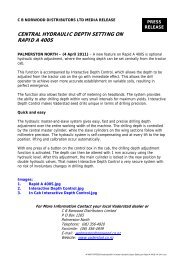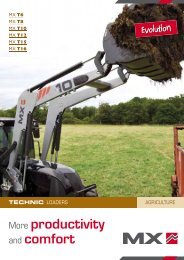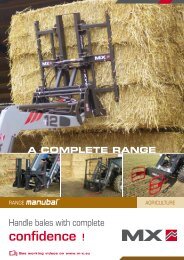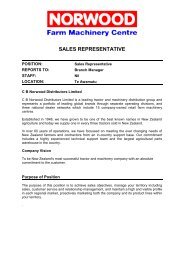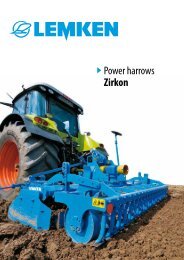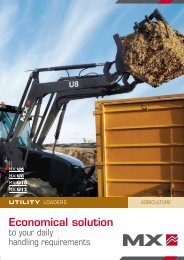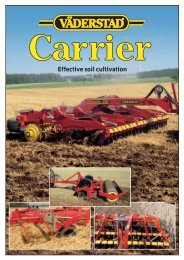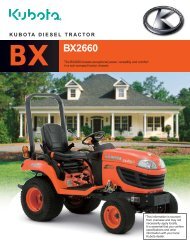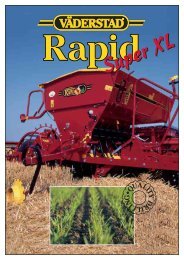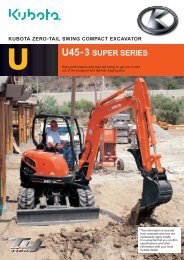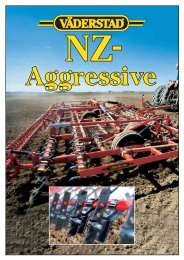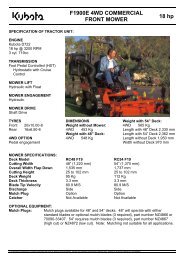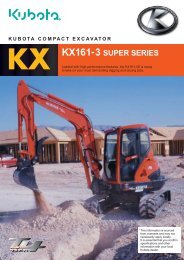Vaderstad TopDown Brochure - LiveUpdater
Vaderstad TopDown Brochure - LiveUpdater
Vaderstad TopDown Brochure - LiveUpdater
You also want an ePaper? Increase the reach of your titles
YUMPU automatically turns print PDFs into web optimized ePapers that Google loves.
<strong>TopDown</strong> works the soil both atthe top and down belowThere is never just one way ofachieving good results in soil tillage.Something that is right forone farm can be completelywrong for another. It all dependson soil type, weather, climateand pre-crop. However, interestin reduced tillage is increasingthroughout Europe and that isnot just a coincidence.There are two great advantages withreduced tillage, the financial and thebiological.Money can be saved on reduced tillagebecause both labour and machinecosts can be reduced. The differencecan be seen in the balance sheet.However, the biological benefits arealso obvious because the soil becomesprogressively easier to cultivate as thestructure improves.Save time and moneyCost reductions and rationalisation offarm size mean that there are fewerpeople working each hectare. Thispattern can be seen in the past historyof farming and the rate of change isunlikely to decrease. The change tocost-effective crop production makesreduced tillage more attractive, sincethe number of hours worked in thefield can be reduced. The increase inthe cost of tillage operations shows nosigns of decreasing, while the price ofgrain unfortunately does not follow thesame uninterrupted upward trend.This means that productivity must beincreased if profits are to be maintained.Reduced tillage allows dieselconsumption to be radically decreased,which means that the costs ofestablishing a new crop are lower. In ahard-pressed economic reality, theselower inputs of time and energy mean areduction in production costs for thefarmer, so profitability in crop productioncan be improved.
Flexible and versatile machineThe new flexible <strong>TopDown</strong> cultivatorfrom Väderstad offers a broad spectrumof possibilities. The great advantageis that <strong>TopDown</strong> is capable notonly of shallow tillage but also deepertillage when the need arises.Stepless working depthWorking depth can be adjusted steplesslybetween 5 and 25 cm. This means that<strong>TopDown</strong> has a wealth of variation and arange of applications encompassingalmost everything that could berequired from a modern soil tillagemachine. In addition to working depth,there are refinements for working inseveral different stages. When the soil istilled progressively - first with discs andthen with tines – the amount of soilclods on the surface is reduced whilefull cultivation of the soil profile is ensured.Works with the conditionsThe independent depth adjustment ofdiscs and tines makes it possible toeasily adapt the work done by<strong>TopDown</strong> to the conditions in eachfield. Some fields only require shallowtillage to prepare the seedbed and thendrill. <strong>TopDown</strong> fits in perfectly. Otherfields require deeper cultivation to mixin large amounts of straw or to loosenhardened layers. <strong>TopDown</strong> is a reliablepartner for this kind of tillage too. Thiswealth of variation is the hallmark of aversatile machine. The degree of soilfirming can also be adjusted from thefree weight of the rollers to the entireweight of the machine resting on thesteel rings. It is difficult to find a moreflexible machine for reduced tillage!
1Front discs – cut up and mix inAt the front are two rows of serratedconical discs with a diameter of 430mm, manufactured from the hard anddurable V-55 steel, which guaranteeslong lifetime and low maintenancecosts. The discs chop up harvest trashand mix it into the upper part of the soil.They work best when the driving speedis high, 10 - 15 km/h. This gives fullincorporation because the discs throwsoil energetically to the side. As soon asthe harvest trash is mixed in, biologicalprocesses set to work and the decompositionrate increases. The workingdepth of the discs can be adjustedsteplessly during work.The 4 points of the2Tines – break up and loosenThe cultivator section of <strong>TopDown</strong>consists of three rows of rigid tinesdeveloped to loosen the soil. Thesetines can be fitted with different pointoptions - 50, 80 or 120 mm wide cultivatorpoints. In addition, the 80 and 120mm wide points can be complementedwith a 300 mm wide wing share. Thewing blades are used when full-widthcultivation is required below theworking depth of the discs and the soilhas to be loosened. The narrow cultivatortines are more suitable for breakingup hardened areas or mixing in largeamounts of straw. One of the advantageswith having two types of points isthat the total draught requirement isreduced. Another advantage is thatthey bring up fewer large clods to thesoil surface.
<strong>TopDown</strong> concept3Rear discs – level and smoothThe rear discs on <strong>TopDown</strong> level outfurrows left by the tines. The soil left bythe rear discs is smoother and moreeven. These discs are mounted onrubber suspension, which ensures goodcontouring and high stone tolerance.The levelling discs can be steplesslycontrolled by the hydraulics from thetractor cab during work. With this kindof technical solution, it is easier to suitthe degree of levelling to the conditionsin individual fields and to the amount ofcoarse material on the soil surface.4Steel rings – firm the soilsurfaceThe final tillage zone on <strong>TopDown</strong>consists of a row of steel rings that firmthe soil. In dry conditions in particular,it is important that the soil is firmed sothat germination of volunteer plantsand weeds is quick and uniform. Thedegree of firming can be controlledaccording to need at every stage fromthe free weight of the rollers to thewhole weight of <strong>TopDown</strong> being carriedon the rings to produce maximumconsolidation. The steel rings have anaggressive profile, which works thestraw and forces it into the surface layerto ensure optimal decomposition rate.The steel rings can also be operated inthe raised position if the conditionsdemand.
<strong>TopDown</strong> is a 3-stage rocket……for shallow tillage of the surface…<strong>TopDown</strong> is suitable for shallow tillagedone directly after the combine. Thecultivator tines are kept in the raisedposition during this operation, whilethe aggressive discs attack straw, chaffand husks. This pass should be ataround 10 - 15 km/h so that the discscan work at their best and throw thesoil to the side. The aim of this operationis to encourage volunteer andweed seeds to germinate as soon aspossible, but also to mix harvest trashinto the surface layer of soil. When thetrash comes into contact with the soiland its microorganisms, the decompositionprocess begins and the first stepis taken towards building up a highhumus concentration in the upper partof the topsoil. The more years of shallowmixing of harvest trash into theupper topsoil, the faster the rate ofdecomposition because the biologicalactivity becomes concentrated to thissoil layer.Another possible way to use <strong>TopDown</strong>is as a conventional cultivator. Thenthe front row of discs is raised whilethe tines in the second of <strong>TopDown</strong>’sfour zones show their considerablecapability. There may be several aimswith this type of tillage operation. Ifsome kind of pan or hard layer hasdeveloped during the growing season,it has to be broken up so that plantroots are not prevented from makingtheir way down through the soil profile.If roots are hindered by a soil pan,…for deep tillage further down …their access to water is limited and theyield potential of the crop is reduced.Another reason for working with cultivatortines is to rip couchgrass rootsapart and pull them up to the surface,where they dry out or use up theirenergy reserves. Tine spacing on<strong>TopDown</strong> is 27 cm and the soil clearanceis high so that large amounts ofstraw can be dealt with. The tines areequipped with hydraulic stone releaseup to 700 kg point power.…or for both shallow and deep tillage<strong>TopDown</strong> utilises its full potentialwhen both discs and cultivator tinesare used together. <strong>TopDown</strong> can thenslice up the entire soil surface, mix inharvest trash and loosen at depth inone pass. The advantage of working intwo stages is that the amount of soilclods brought up to the surface isdecreased. This ability to handle bothshallow and deep cultivation distinguishes<strong>TopDown</strong> from other soil tillagemachines. The tips on the three rowsof rigid tines can be substituted or variedaccording to the task. There arethree different types of points 50, 80and 120 mm wide. <strong>TopDown</strong> can alsobe equipped with wing shares. Whenfull slicing is required, the 300 mmwide wing blades are used to penetrateand break up the soil a further fewcentimetres down from the workingdepth of the discs. To break up deepsoil compaction, for example a ploughpan, the straight cultivator points arethe recommended option becausethey can work down to 25 - 30 cm depthand break up the soil as efficiently aspossible.
Reduced tillage wIn reduced tillage, it is importantto set biological targetsthat should be implementedand achieved. Increasing thehumus concentration in theupper topsoil can be such atarget. It improves the reliabilityof crop emergence since therisk of soil crusting is reduced.Better drainage in the soilprofile can be another target. Itis achieved because earthwormsthrive when the ploughis left idle.Higher humus content at the surfaceAn increase in the humus concentrationin the upper topsoil is one of the greatestadvantages of shallow, reduced tillage.Many farmers who have practised reducedtillage for decades often view that asthe most important aim. Since harvesttrash is not mixed into a deep soil layer,the amount of humus in the uppermostlayer increases, while further down inthe soil profile it decreases. Reduced tillageis a question of redistributing thesame amount of harvest trash over ashallower depth.More reliable emergenceThe risk of crusting decreases as a resultof the humus increase in the surfacelayer. This improves crop establishmentand makes it more reliable, particularlyon weak-structured soils with a low claycontent or on silty soils. If it rains soonafter drilling, the high humus concentrationat the surface comes into effect. Thestraw cylinders embedded in the transition,between the soil surface and the air,that have not yet decomposed also havethe effect of creating aeration channelsaround them.
orks with natureHow to begin!Even if the aim is clear, the route toreduced tillage can be hard to find.Here are some tips to help you onyour way.Straight after the combineA first pass should be made as soonas the combine has left the field.Such quick action has many advantages.The soil is softest just afterthe crop has been harvested andthe machine can easily work its waythrough. The firmed soil left by thisfirst pass also forms a barrier toevaporation, so soil water is conserved.In addition, weed seeds andvolunteers germinate at once, sothey can be controlled mechanicallyor chemically at a later stage.Loosen if neededA second pass is always of benefit iftime allows. The first pass starts thedecomposition of harvest trash,while the second can be dedicatedto achieving a particular outcome. Ifthe soil structure at depth is good,the soil does not need to be loosened,so the second pass can be arepeat of the first. However, if thesoil is in need of loosening at depthbecause of hardness or a pan, thesecond pass can well be devoted tobreaking up this dense layer.Worms thriveBetter drainageA clear effect of converting to reduced tillageis the improvement in the earthwormpopulations in the soil. This change occursrather soon – after only three years of reducedtillage to 10 cm, the quantity of earthwormsis doubled in terms of both numbersand weight compared with ploughed soil.This is particularly true for the importantearthworm species that dig vertical channelsin the soil. They look for their food atthe soil surface and are favoured if harvesttrash is concentrated at the surface and notdistributed to ploughing depth.When the soil is not loosened by theplough each year, some compaction candevelop in the lower topsoil. On theother hand, the plough pan is graduallyloosened up. The soil pores in the transitionbetween topsoil and subsoil remainintact when they are not disrupted byploughing. They interconnect to create anetwork, which means that drainage ofwater through the soil gradually improvesover time. This effect can be enhancedby the activity of earthworms, whichimproves both drainage and aeration.The best way of deciding whatdeep tillage is needed is to dig ahole by hand in the field. The soilstructure can then be examinedand assessed and the diagnosis canbe used to decide the need forloosening.
The tines on <strong>TopDown</strong> can be equipped with threedifferent types of points – 50, 80 or 120 mm wide. Thetwo wider points can also be complemented with 300Two strategies with <strong>TopDown</strong>mm wide wing shares. This provides a range of tillagepossibilities based on two main strategies. The<strong>TopDown</strong> is as standard equipped with 80 mm points.1. Wide wings cut …For shallow and normal tillage, the points are used with the wing shares fitted.They produce a soil profile that is completely tilled and aerated since the angleof the wing shares raises the soil up. The advantage of this operation is thatroots of e.g. couchgrass are cut off. At the same time, the entire soil volume ismixed together with harvest trash down to tillage depth.2. Deep grooves drain…For deep tillage, the narrower points are used without wing shares. When tillageis mainly being carried out to loosen and to break up a pan, then this alternativecomes into its own. The soil profile left by the tines is a landscape of hillsand valleys. Where the tine points have etched their pattern, excess water canrun off from the soil profile.
Investing in <strong>TopDown</strong> brings benefits far into thefuture. To ensure a long lifetime, our machinesQuality that lastsare tested under extreme conditions in parallelwith development work.Rubber suspension takes theknocksThe rubber suspension is a uniqueconstruction from Väderstad and itsability to absorb knocks and vibrationsgives the roller its superiordurability. The rubber suspension isvery durable and maintenance free.V-55 withstands tough conditionsThe serrated discs of special hardenedsteel on <strong>TopDown</strong> force their wayaggressively into the soil. <strong>TopDown</strong> isequipped with V-55 discs, with a lifetimeup to 50% longer than that of theprevious material. This means minimummaintenance.430 mmHeavy roller crushes clodsThe heavy and powerful roller ringswith a diameter of 600 mm firm thesoil surface and crush clods efficiently.The rings are manufactured fromthe same hard material as the discs,which gives a long lifetime. Each ringalso acts as a spring plate, whichremoves the need for after-tighteningof the roller package. The smoothsides of the rings provide them aphenomenal ability to work in dampand wet conditions without strawand clay sticking to them.
‘Exceeds expectations’Englishman David Jonesthinks he has found theperfect soil tillage implement.It comes from Sweden and iscalled <strong>TopDown</strong>.David Jones farms 1100 hectares nearStratford-on-Avon in central England.He is one of the first to use <strong>TopDown</strong>in Great Britain. After having workedhis <strong>TopDown</strong> on 400 ha, David isimpressed by its action in the field.Exceeds expectations‘We have used minimal tillage for thepast seven years and I have to say that<strong>TopDown</strong> exceeds my expectations’,says David. He opted for the 6-metreversion of the machine, which hedraws with a 450 hp Case Quadtrac.‘I can drive at up to 12 km/h and manage40 hectares in a day without havingto exert myself’, he reports.Halved diesel billDespite the fact that he has all typesof soil from light sandy loams toheavy clays, David Jones is convincedthat <strong>TopDown</strong> can manage to createan acceptable seedbed in one pass onthe vast majority of these soils.Fuel economy is also a plus. David ishappy to report that his diesel costshave been halved.‘With <strong>TopDown</strong> I use just under 8litres of diesel per hectare comparedwith 14 litres for ploughing’.On 1100 hectares, that comes to aconsiderable amount of diesel.Country: EnglandFarmer: David JonesFarm: BlackhillCounty: WarwickshireArea: 1100 ha
‘Positive impression’After the first 200 hectares ofwork, Fredrik Kvantenå ishappy with his <strong>TopDown</strong>. Themachine does a fine job andcuts down on passes.Fredrik Kvantenå farms QvantenburgsSäteri together with his father Sören.They decided to invest in reduced tillageon the farm. They kept the plough towork in parallel, but were attracted bythe advantages of reduced tillage.Technical progress‘We want to drive on the soil as littleas possible. Diesel is very expensive’,says Fredrik Kvantenå.The choice was <strong>TopDown</strong>. The familyhas previously used a VäderstadCultus and it was patently obvious toFredrik Kvantenå that there had beengreat technological changes. Onepass with <strong>TopDown</strong> corresponds totwo passes with Cultus. Fredrik alsoappreciates the level and smooth soilsurface left by <strong>TopDown</strong>:‘It makes drilling easier’.Short stubble importantAfter 200 hectares of <strong>TopDown</strong> work,Fredrik Kvantenå has come to someconclusions.‘Keep stubble short. We had moreproblems with stubble than strawbecause the crop suffered fromlodging’.Fredrik thinks that the work done bythe discs is excellent. And with thewing shares on the points, the tinesection does a better job:‘Harvest trash is mixed in better’.Overall, he is pleased with the newmachine:‘It has made a positive impression’.Country: SwedenFarmers: Sören and FredrikKvantenåFarm: Qvantenburgs SäteriCounty: DalslandArea: 600 ha
Specifications:Model Working- Transport- Weight Wheel Horse power Commentswidth widthm m kg caTD 400 4 3 6200 520x17 200-240TD 500 5 3 6900 520x17 250-300TD 600 6 3 8800 520x17 och 400x15,5 300-360TD 700 7 3 9600 520x17 och 400x15,5 350-420°°°°°°°°Simple unfolding<strong>TopDown</strong> folds out easily from transport to working mode.The broad wheel base on <strong>TopDown</strong> ensures safe transport athigh speed on uneven surfaces.Narrow on roadAll <strong>TopDown</strong> models are only 3 m wide in transport mode,regardless of working width in the field (4 - 7 m). The sturdywheel equipment provides good stability during transport.VÄDERSTAD Ltd.Unit One, Ellesmere Business ParkGrantham, Lincolnshire NG31 7XTTel. 01476 581 900 • Fax 01476 581 901www.vaderstad.comDistributor:990702-ENGB Mjölby Tryckeri AB/Desktopteknik AB 2005.09The company retains the right to make changes to specifications and design. Patents awarded and pending



